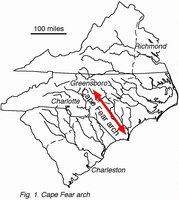Environmental effects of uplift in North Carolina, United States
| Topics: |
 Figure 1: Cape Fear arch, North Carolina. (Source: History and Environment of North Carolina's Piedmont)
Figure 1: Cape Fear arch, North Carolina. (Source: History and Environment of North Carolina's Piedmont) The Earth's surface environment is partly controlled by processes deep within the earth. These "tectonic" processes cause obvious features, such as mountain ranges and volcanoes, and also more subtle features that can have profound environmental consequences.
North Carolina's environment is largely controlled by one of these subtle features. North Carolina differs from other southeastern coastal states because unexplained tectonic processes create an uplift known as the Cape Fear arch (Fig. 1). The arch extends across North Carolina along a line that approximately follows the Cape Fear River in the coastal plain. Uplift began at least 150 million years ago, causing sediments deposited since that time to be thin on top of the arch and thicker in basins both to the north and south. Terraces along the river also show that the arch continues to rise at a rate of a few centimeters per year.
The arch affects geography across the entire State of North Carolina. The Appalachian Mountains are higher in western North Carolina than in Virginia or South Carolina. The North Carolina piedmont is also several hundred feet higher than the piedmonts in Virginia and South Carolina. This extra elevation has four effects:
 Figure 2: North Carolina fall zone. (Source: History and Environment of North Carolina's Piedmont)
Figure 2: North Carolina fall zone. (Source: History and Environment of North Carolina's Piedmont) - North Carolina does not have a conventional "fall line" of the type that can be seen easily at Richmond, Virginia, or Columbia, South Carolina. Instead, North Carolina has a "fall zone" in which rivers lose several hundred feet of elevation over a distance of about 100 miles (Fig. 2).
- Most rivers with headwaters in interior North Carolina flow out of the state either north or south before they reach the Atlantic Ocean (Fig. 2).
- Erosion has been more intense in the North Carolina piedmont than in the north and south, thus leaving North Carolina with poorer and thinner soils than those in the piedmonts of Virginia and South Carolina. This heavy load of eroded sediment is carried mostly down the Cape Fear River, causing Cape Fear to jut out into the Atlantic and depositing extensive shallow-water sediments known as "Frying Pan shoals."
- The barrier islands along the coast of the southeastern United States are much farther from the mainland in North Carolina than in Virginia or South Carolina.
All of these consequences of the Cape Fear arch have affected human history ever since the first colonists arrived more than 400 years ago.
- The high elevation of the mountains forced colonists who wanted to move west from North Carolina to go either north, to the Cumberland Gap in Virginia, or to lower passes in South Carolina.
- Colonists who lived in the North Carolina piedmont traded goods through Richmond, Virginia, which was a port right on the fall line, or through Charleston, South Carolina.
- When textile, lumber, and other mills were built in the South following the Civil War, many of them were located in the fall zone in order to take advantage of the high hydraulic head of the rivers over a long river distance.
Problems caused by the Cape Fear arch continue even in the 21st century.
- The North Carolina ports of Morehead City and Wilmington are far smaller than either Richmond or Charleston.
- The North Carolina piedmont frequently experiences water shortages because so many rivers flow out of the state.
- The poor soils of the piedmont make agriculture only a minor contributor to North Carolina's economy, with the only major components being chickens, hogs (in the coastal plain), and nursery plants.
Further Reading
- More information on this topic is in a book by John J.W. Rogers titled History and Environment of North Carolina's Piedmont – Evolution of a Value-Added Society.